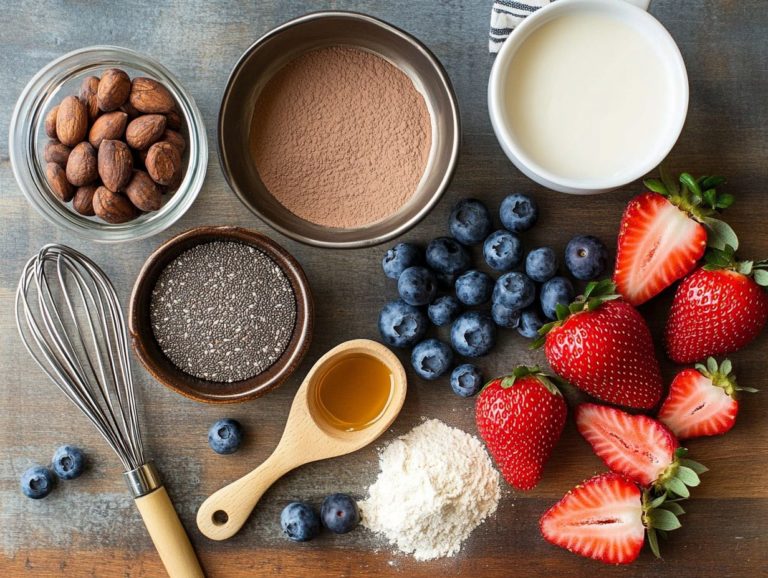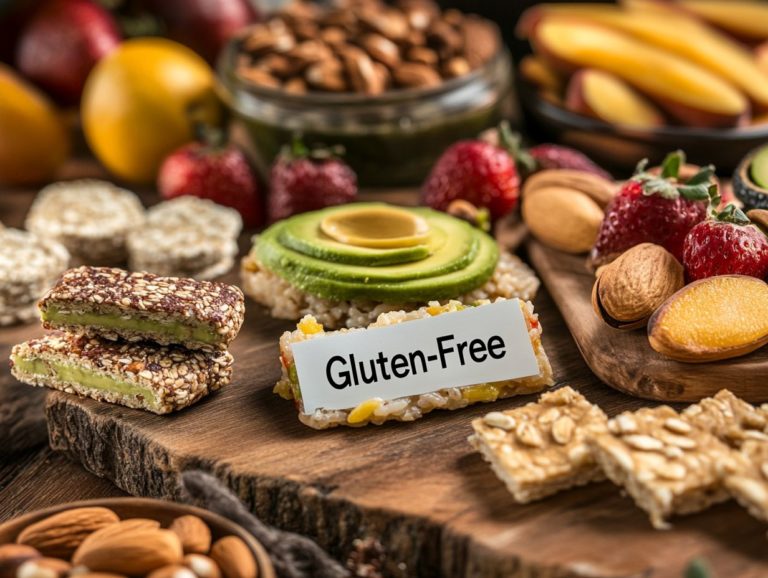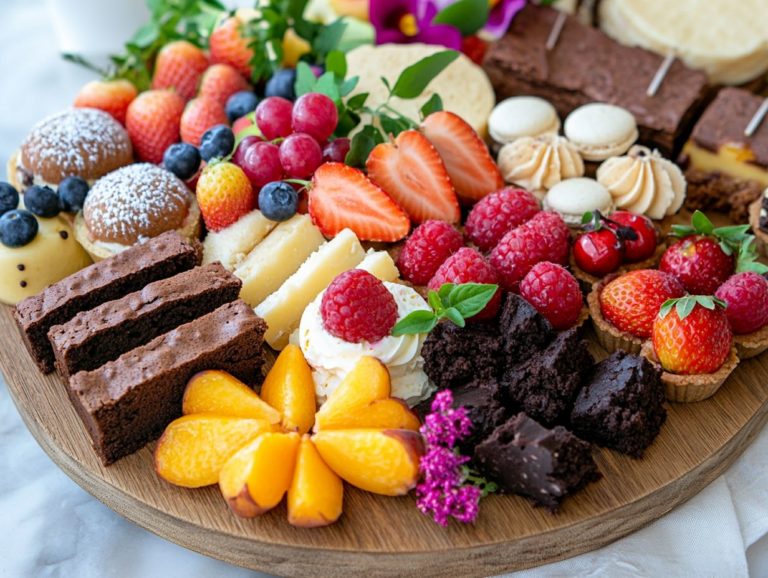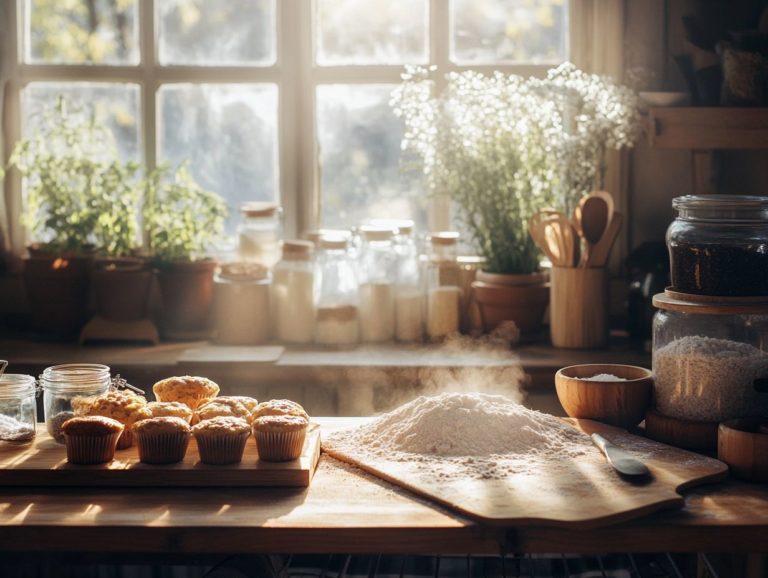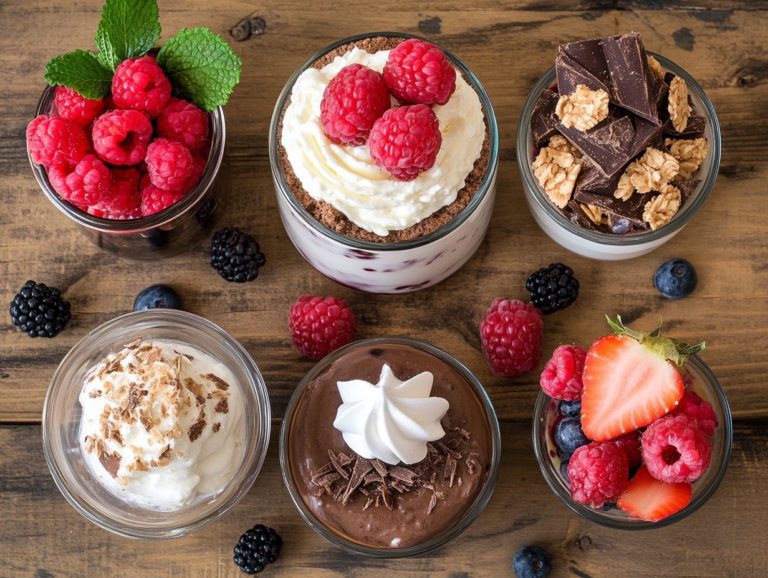How to Make Gluten-Free Cookies: A Step-by-Step Guide
Gluten-free cookies are a delightful indulgence that anyone can savor, whether you re managing celiac disease, navigating gluten sensitivity, or simply seeking healthier baking alternatives. These scrumptious homemade cookies are perfect for anyone.
This guide provides you with the essential ingredients required for crafting the perfect gluten-free cookie recipe, alongside a clear, step-by-step guide and expert tips to guarantee that your cookies come out just right.
Whether you re an experienced baker like Erin or Christine, or stepping into the kitchen for the first time, you ll discover everything you need to satisfy your sweet cravings without the gluten.
In this guide, we’ll cover everything from the types of gluten-free flour to use, like almond flour, to the best cooking tips for achieving chewy cookies. We’ll also explore how to use baking powder, sugar, and vanilla extract in your recipes for optimal results.
Contents
- Key Takeaways:
- Why Choose Gluten-Free Cookies?
- What Ingredients Do You Need for Gluten-Free Cookies?
- Gluten-Free Sweeteners
- Gluten-Free Flavorings
- How to Make Gluten-Free Cookies: A Step-by-Step Guide
- 1. Preheat Your Oven
- 2. Prepare Your Ingredients
- 3. Mix Dry Ingredients
- 4. Cream Butter and Sugar
- Guide to Making Gluten-Free Cookies
- Top Tips for Perfect Gluten-Free Cookies
- Frequently Asked Questions
- Q1: What ingredients do I need to make gluten-free cookies?
- Q2: Can I use regular flour to make gluten-free cookies?
- Q3: How do I know if my cookies are gluten-free?
- Q4: Do I need any special equipment to make gluten-free cookies?
- Q5: How do I prevent my gluten-free cookies from crumbling?
- Q6: Can I freeze gluten-free cookie dough?
Key Takeaways:
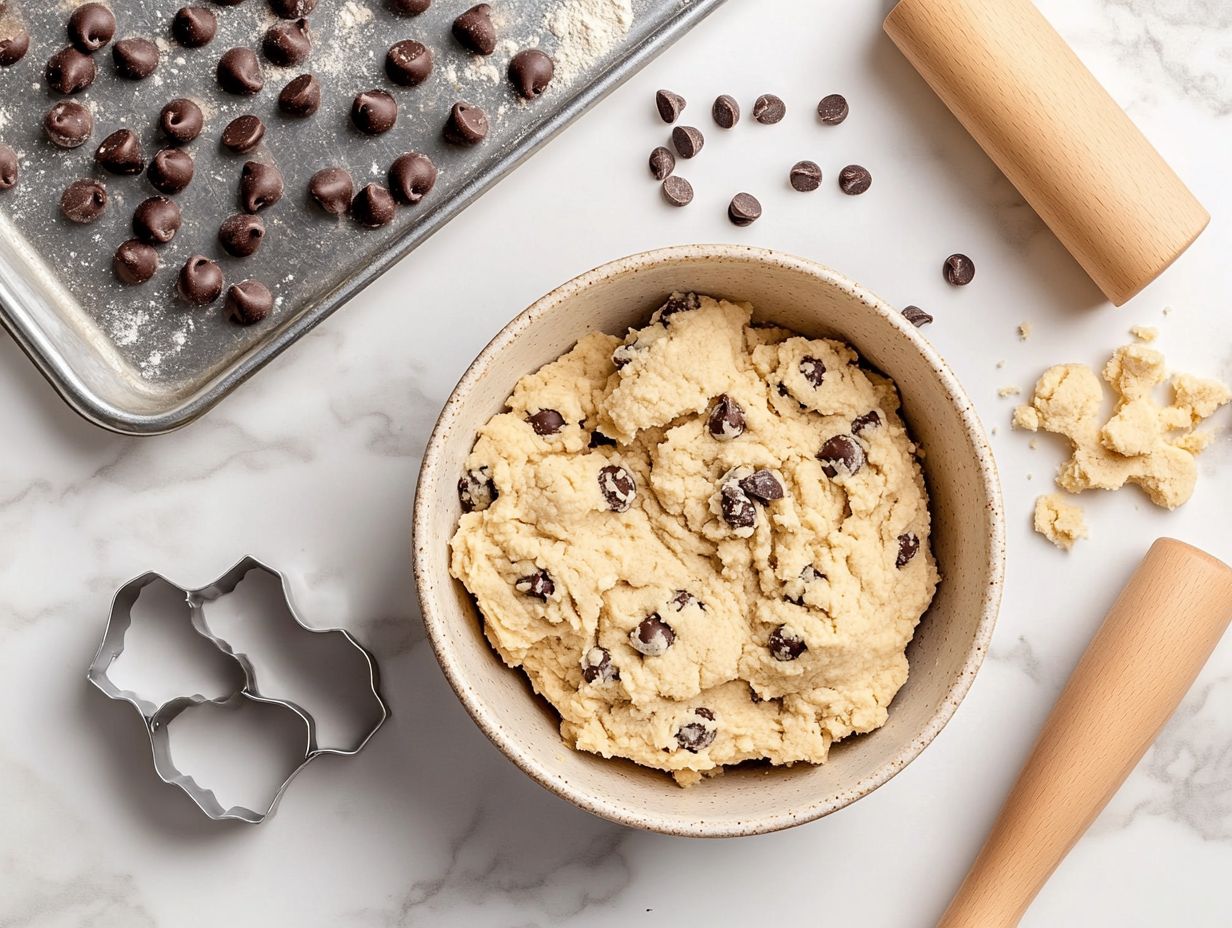
- Choose gluten-free cookies for those with celiac disease or gluten sensitivity.
- Substitute gluten-free flour, such as almond flour or gluten-free measure-for-measure flour, binders, sweeteners, and flavorings in your recipe.
- Follow recipe instructions, use a kitchen scale, chill dough, and experiment with different flours like King Arthur Flour or Bob’s Red Mill for perfect gluten-free cookies.
Why Choose Gluten-Free Cookies?
Opting for gluten-free cookies presents a delightful alternative for anyone navigating gluten allergies or celiac disease, enabling you to relish treats without sacrificing your health. These cookies often feature semi-sweet chocolate chips for added indulgence.
With the increasing prevalence of gluten sensitivity, many dedicated bakers are crafting Gluten-Free Chocolate Chip Cookies that not only quell your cravings but also align perfectly with a gluten-free lifestyle.
By utilizing gluten-free flour and thoughtful dietary substitutions, you can indulge in these scrumptious homemade cookies, regardless of your dietary restrictions.
Gluten-free baking is becoming more popular across the United States, making it simpler than ever for you to discover or create recipes that cater to your specific dietary needs.
1. For People with Celiac Disease
For those diagnosed with celiac disease, consuming gluten can unleash a cascade of serious health problems, making gluten-free cookies not just a safe option, but a truly joyful treat.
The implications of this long-term illness are significant; ingesting even the smallest trace of gluten can lead to very serious health problems and long-term complications, including nutritional deficiencies, digestive issues, and even neurological problems.
Adhering to a strict gluten-free diet isn’t simply a matter of preference for you it’s an essential lifestyle requirement that must be followed diligently to safeguard your health and well-being.
Fortunately, gluten-free cookies step in as a delightful alternative, allowing you to indulge your sweet cravings without jeopardizing your health. These delicious cookies not only keep you safe but also let you enjoy your favorite flavors! For thicker cookies, consider using unsalted butter and a bit of flaky salt to enhance the flavor.
2. Understanding Gluten Sensitivity
If you have gluten sensitivity, you re likely all too familiar with the discomfort that can arise after consuming gluten. This reality underscores the importance of gluten-free alternatives, such as gluten-free cookies, which can help alleviate those pesky symptoms.
You might encounter a variety of uncomfortable sensations, including bloating, abdominal pain, diarrhea, and fatigue. These can significantly affect your quality of life. Excitingly, gluten-free baking offers a fantastic variety of options to accommodate your dietary needs without sacrificing flavor or enjoyment.
For example, incorporating almond flour, coconut flour, or oat flour into your cookie recipes can yield delightful results that are safe for those avoiding gluten. Don’t forget to add granulated sugar and vanilla extract to enhance the sweetness and flavor.
As you transition to a gluten-free diet, it’s essential to read labels carefully and explore dedicated gluten-free brands. Enjoy experimenting with homemade gluten-free cookies, allowing you to customize them to your personal tastes while ensuring you have a safe and satisfying snack option. Freezing cookie dough can also be a handy tip for quick baking later.
What Ingredients Do You Need for Gluten-Free Cookies?
To create mouthwatering gluten-free cookies, you ll want to gather a selection of specialized ingredients that gracefully replace traditional options while maintaining exceptional taste and texture. Remember to use unsalted butter and baking soda for an ideal cookie base.
Start with gluten-free flour alternatives, such as almond flour or a gluten-free measure-for-measure flour, which will serve as the backbone of your cookie dough. Don t forget to include gluten-free binders like eggs or mashed banana. Also, include gluten-free sweeteners such as granulated sugar, as these are essential for achieving that ideal cookie consistency. Adding baking powder will help your cookies rise beautifully.
Finally, enhance your gluten-free cookie masterpiece with delightful flavorings like vanilla extract and sumptuous mix-ins like semi-sweet chocolate chips, elevating your creation to a new realm of indulgence.
1. Gluten-Free Flour
Gluten-free flour is a crucial component in crafting the perfect base for your gluten-free cookie recipe. You’ll find a delightful array of options at your fingertips, including almond flour, King Arthur Flour, and Bob’s Red Mill gluten-free measure-for-measure flour, each catering to different palates and textures. For the best results, follow recipe instructions closely to ensure proper consistency.
Each type of flour offers unique qualities that can dramatically influence the texture and flavor of your cookies. For example, almond flour imparts a rich, nutty flavor and a moist texture, making it an excellent choice for chewy cookies. On the other hand, coconut flour tends to absorb more moisture, necessitating the addition of extra liquid to your recipe.
When it’s time to source these gluten-free flours, look no further than health food stores, specialty grocery shops, or the vast world of online retailers. To attain the best possible results, it s essential to adhere to precise measuring guidelines and consider blending different flours, as this can elevate the overall structure and flavor of your baked creations. Always check for gluten contamination in your cooking equipment to ensure a safe baking environment.
2. Gluten-Free Binders
Gluten-free binders are essential for holding the ingredients together in your cookie recipes. Consider options like eggs or bananas; they excel at maintaining both structure and moisture.
These binders not only prevent your cookies from crumbling but also significantly enhance their overall texture, resulting in a chewy, delightful treat that rivals traditional baked goods. If you’re exploring alternatives, ground flaxseed mixed with water or chia seeds serve as excellent vegan-friendly substitutes, effectively mimicking the binding properties of eggs. Using dairy-free alternatives like unsalted butter can also make your cookies suitable for more dietary needs.
You might also want to consider incorporating substances like xanthan gum or guar gum, natural thickening agents that help improve cookie texture, to improve elasticity and cohesion, ensuring that your final product retains that coveted chewy consistency. By recognizing the vital role these binders play, you can craft delicious gluten-free cookies that everyone will love.
Next, let’s explore the ingredients that add flavor to your gluten-free cookies.
Gluten-Free Sweeteners
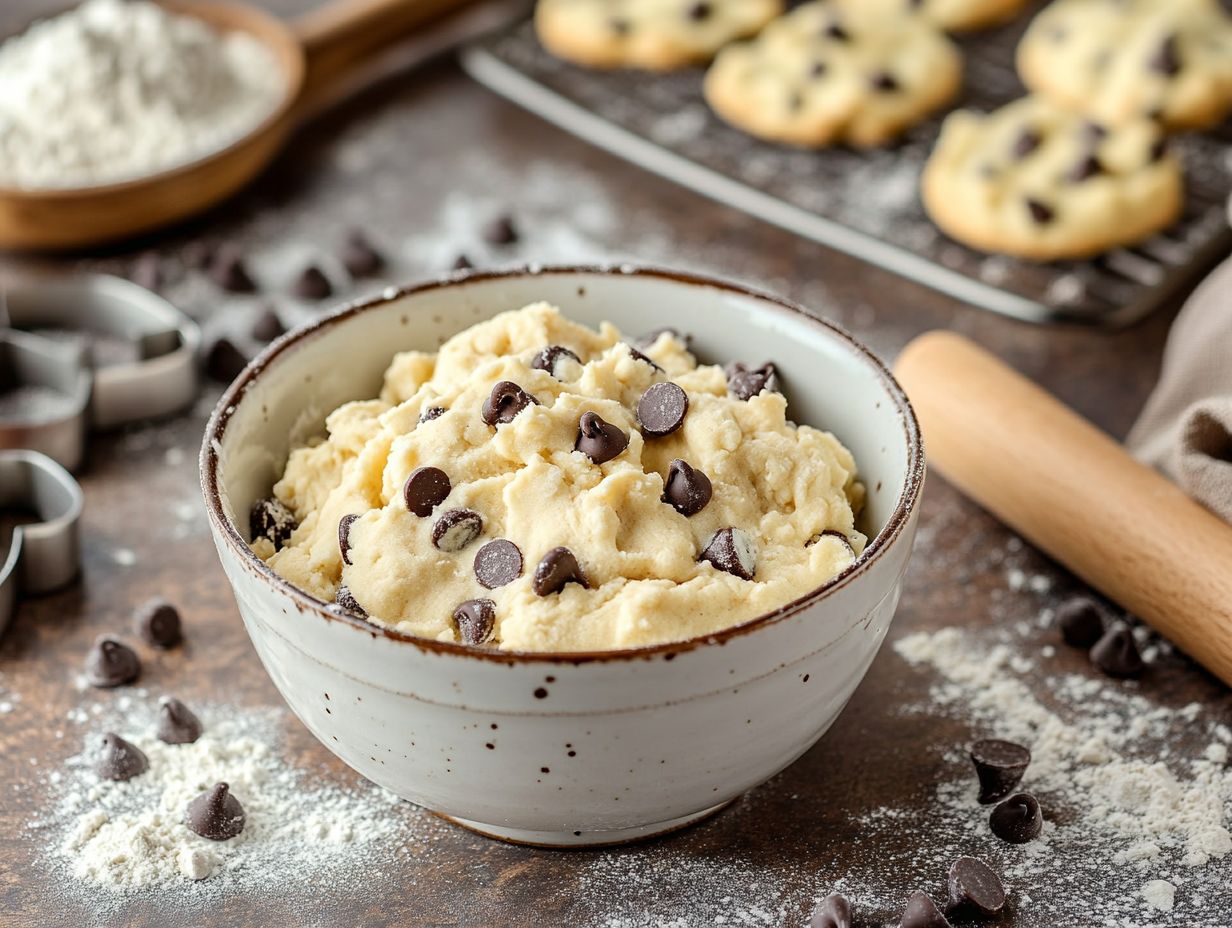
When you think about gluten-free sweeteners, granulated sugar might come to mind. However, don t overlook the alternative sweeteners that can elevate your cookie recipes.
Using sugar alternatives like erythritol or monk fruit extract can create delicious, low-carb cookies.
If you’re aiming to cut back on sugar, options like coconut sugar and stevia are fantastic choices. Stevia, in particular, packs a punch with its sweetness, allowing you to enjoy flavor without the hefty calorie count.
Maple syrup and agave nectar also bring their own delightful taste profiles to the table. Just keep in mind that they introduce moisture, which may necessitate some adjustments to your cookie’s dry ingredients.
It’s important to understand how these alternatives can affect not just sweetness, but also texture. Using a liquid sweetener might lead to cookies that are softer than you d prefer.
For those with specific dietary restrictions, sweeteners like erythritol or monk fruit extract are excellent low-carb options that deliver a satisfyingly sweet flavor without compromising on quality.
Gluten-Free Flavorings
Gluten-free flavorings, like pure vanilla extract and baking powder, play a crucial role in elevating the taste profile of gluten-free cookies. They ensure they match the deliciousness of their traditional counterparts.
In addition to vanilla, consider incorporating almond extract for a delightful nuttiness. You can also add some citrus zest like lemon or orange for a refreshing brightness that truly enhances the cookie’s appeal.
Spices such as cinnamon or nutmeg can infuse warmth and depth, making every bite irresistibly enticing.
When selecting flavorings, prioritize high-quality, pure extracts over imitation options. The former offers a richer taste and typically contains fewer additives.
Always check that any flavoring is labeled gluten-free, especially when it comes to baking powders and flavor extracts, as cheaper formulations may sneak in gluten.
By thoughtfully curating these elements, you can create gluten-free cookies that not only tantalize the taste buds but also hold their own against even the most cherished traditional varieties.
How to Make Gluten-Free Cookies: A Step-by-Step Guide
Creating gluten-free cookies is an effortlessly satisfying endeavor when you adhere to the right recipe instructions. By doing so, you can ensure your cookies emerge chewy and utterly delicious every single time.
Begin by gathering your essential ingredients, such as gluten-free flour and baking powder. Make sure to set your oven to the perfect temperature for that ideal bake.
Pay attention to each step, from meticulously mixing the dry ingredients to the final baking process. Don’t forget the delightful option of freezing cookie dough for future indulgence.
This guide is designed to make your gluten-free baking an enjoyable experience. Get ready to enjoy classic Gluten-Free Chocolate Chip Cookies and explore exciting new flavors!
1. Preheat Your Oven
Setting your oven temperature correctly is crucial for gluten-free baking.
Brands like King Arthur Flour and Bob s Red Mill offer high-quality gluten-free flour that helps achieve thick cookies.
Preheating your oven to the right temperature is essential for achieving the perfect texture and consistency in your gluten-free cookies.
This ensures they bake evenly and thoroughly.
An accurate preheating process establishes a stable baking environment, which is particularly important when working with gluten-free flours that can behave differently in response to heat.
Setting your oven temperature between 350 F and 375 F strikes a perfect balance for most gluten-free recipes.
This advice is shared by baking experts Erin and Christine, who provide insights for the best results.
For precise temperature control, use an oven thermometer, as many home ovens can be off by several degrees.
If adjustments are necessary, allow the oven to preheat fully before placing the dough inside; this crucial step enhances rise and prevents underbaking.
Keep in mind that oven settings can vary, so watching those cookies carefully as they bake will help achieve a perfect golden brown finish.
2. Prepare Your Ingredients
Preparing your ingredients in advance streamlines the baking process.
This ensures your gluten-free cookie recipe comes together seamlessly, without any unwelcome surprises.
By measuring and organizing all components beforehand, you can minimize stress and maximize efficiency in the kitchen.
Precise measurements are essential especially with gluten-free flours, which can differ significantly in density from traditional wheat flour.
To achieve this effectively, use clear containers and labels to keep your ingredients sorted.
This maintains a tidy workspace and provides a quick visual check to ensure you haven’t overlooked any crucial element.
Having all your tools mixing bowls, spatulas, and baking sheets within easy reach enhances your workflow.
This makes your time in the kitchen enjoyable and productive.
3. Mix Dry Ingredients
Always be mindful of potential food contamination when measuring and mixing your ingredients.
Mixing the dry ingredients correctly is essential for achieving the perfect texture in your gluten-free cookies.
This ensures that ingredients like gluten-free flour and baking powder are evenly distributed throughout the mixture.
This careful process not only elevates the overall flavor but guarantees that each cookie bakes uniformly, sparing you from any unpleasant surprises.
Accurate measurement of each component is crucial, as even a slight discrepancy can significantly alter the texture and taste.
Begin by sifting the gluten-free flour to aerate it.
Then, carefully add the baking powder and a pinch of salt, both vital for flavor enhancement.
Using a whisk, gently combine these ingredients in a large bowl to achieve a consistent blend.
To obtain a uniform mixture free of lumps, mix thoroughly to ensure that every particle interacts with one another.
This diligence results in the ultimate cookie dough consistency that is both inviting and delicious.
4. Cream Butter and Sugar
Creaming together unsalted butter and granulated sugar is a crucial step in your gluten-free cookie-making journey.
This process introduces air into the mixture, resulting in cookies that are delightfully light and chewy.
This step affects the texture and elevates the flavor, creating a rich foundation for your other ingredients.
To achieve the ideal creamy consistency, start with softened butter, ensuring a smooth blend with the sugar.
Begin mixing at a moderate speed, gradually increasing as the ingredients come together.
Continue to cream the mixture until it reaches a fluffy, pale color indicating that the air has been effectively incorporated.
A well-creamed mixture is the cornerstone of perfect cookies, contributing to their tenderness and enhancing your overall enjoyment.
Try these tips and enjoy baking delicious gluten-free cookies!
Guide to Making Gluten-Free Cookies
5. Add Eggs and Vanilla
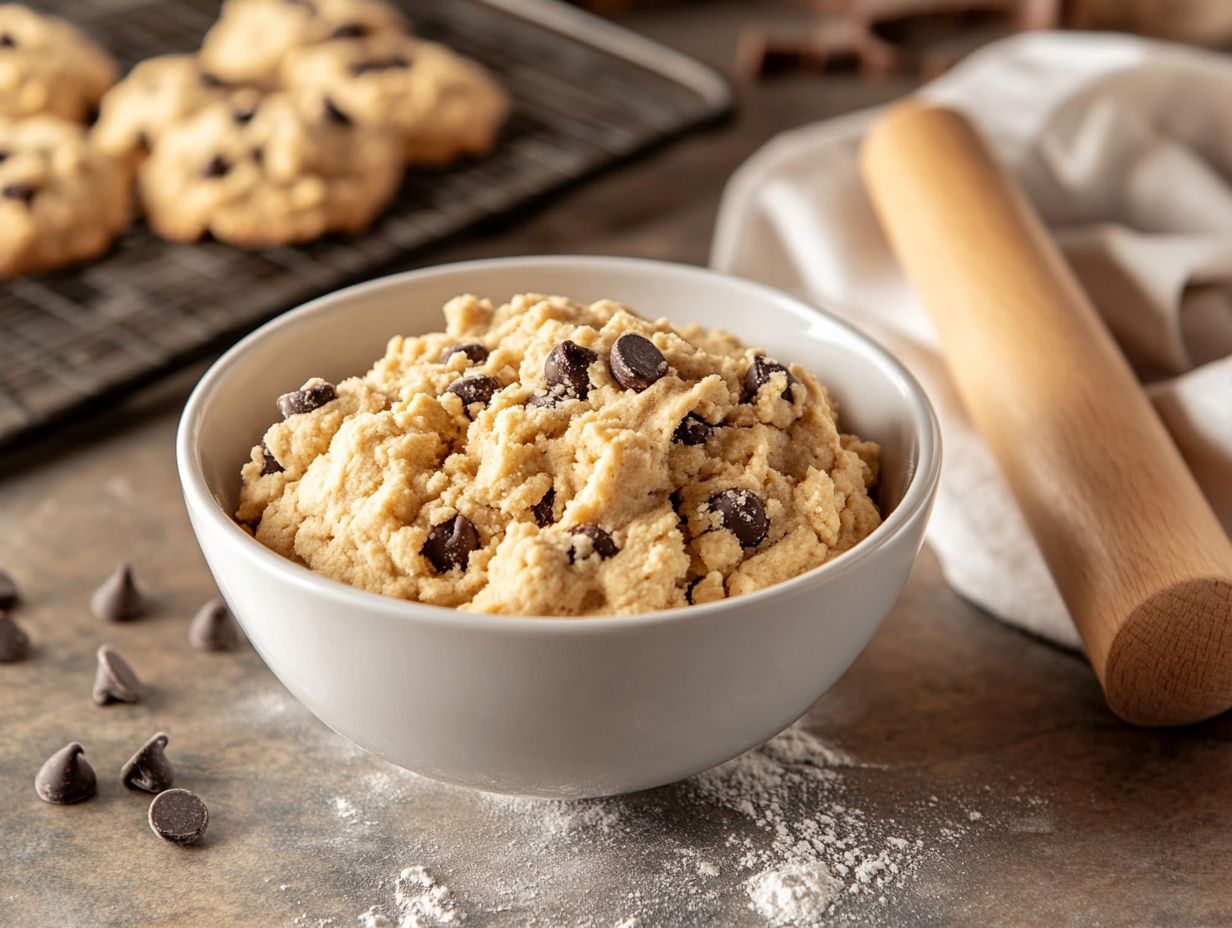
Add eggs and a splash of vanilla extract to enhance the flavor. This step binds the ingredients, transforming your gluten-free cookies into something exceptional.
As you embark on your gluten-free baking journey, understanding how these components interact is key to achieving a delightful texture. Eggs bring moisture and elasticity to the mix, ensuring your cookies won t turn out dry or crumbly.
Vanilla extract adds a rich flavor that boosts sweetness and fills your kitchen with an irresistible aroma as the cookies bake. If you re navigating dietary restrictions, fear not there are effective egg substitutes like applesauce or flaxseed meal that can replicate these qualities.
These alternatives maintain the desired consistency and enhance the overall flavor profile, catering to a range of dietary needs.
6. Mix in Dry Ingredients
Once your wet ingredients are beautifully combined, gently incorporate the dry ingredients. Be cautious not to overmix; this is key to keeping your gluten-free cookies delightfully chewy.
Start by sifting together your dry ingredients, such as almond flour and baking powder, and gradually fold them into the wet mixture. This technique prevents clumping and promotes an even distribution of flavors throughout.
When combining the mixtures, use a spatula or wooden spoon and employ a gentle folding motion. This method minimizes the incorporation of air and helps maintain that perfect consistency.
It’s perfectly fine to have small streaks of flour; they will blend beautifully during the baking process, resulting in cookies that are simply divine.
7. Fold in Any Additional Mix-ins
Folding in additional mix-ins, like semi-sweet chocolate chips, transforms your gluten-free cookies into delightful surprises, allowing you to customize them to suit your taste.
Incorporating a variety of mix-ins enhances flavor profiles and adds texture and visual appeal to every bite. Imagine the satisfying crunch of walnuts or pecans, perfectly complemented by the fruity tang of dried cranberries or apricots that balances the sweetness.
For a fun twist, why not toss in coconut flakes or a sprinkle of sea salt? These additions can elevate the overall taste experience.
To make the most of these mix-ins, blend them evenly into the dough just before baking, ensuring each cookie is infused with a burst of flavor. Experimenting with different combinations can lead to delightful results, making your gluten-free cookies a versatile treat for any occasion.
8. Scoop Dough onto Baking Sheet
Use a reliable cookie scoop to place your gluten-free cookie dough onto a baking sheet with precision. This ensures even baking, so each cookie comes out with the perfect shape and size.
Opt for a scoop size that aligns with your preferred cookie dimensions for uniform cookies that bake at the same rate. This prevents the unfortunate scenario where some cookies end up overcooked while others remain underdone.
Make sure to leave adequate space typically about two inches apart to allow for proper spreading during baking. As a good rule of thumb, try to place no more than 12 cookie dough portions on a standard-sized baking sheet.
For an extra touch of uniformity, consider using a kitchen scale to measure each portion by weight. This ensures every cookie delivers the same delightful texture and flavor profile, leaving no room for disappointment.
9. Bake and Cool
Baking your cookies at the perfect oven temperature and allowing them to cool properly are crucial steps in achieving the best results. This guide provides the latest tips and techniques for gluten-free baking.
For gluten-free cookies, you ll want to preheat your oven to around 350 F (175 C). This temperature promotes even baking and helps your cookies retain their delightful shape.
As you bake, keep a close eye on the timer; most gluten-free cookie recipes typically take about 10 to 12 minutes. Be careful not to overbake them, as doing so can lead to a dry texture that nobody enjoys.
Once your cookies are out of the oven, it s crucial to let them cool on the baking sheet for about 5 minutes before moving them to a wire rack. Letting them cool helps improve their texture, allowing them to stay soft on the inside while developing a wonderfully crisp exterior.
Top Tips for Perfect Gluten-Free Cookies
To craft the ideal gluten-free cookies that are both chewy and bursting with flavor, you’ll want to embrace expert cooking tips and techniques that seamlessly transition traditional baking methods into gluten-free baking.
1. Use a Kitchen Scale
King Arthur Flour and Bob’s Red Mill are both trusted brands that offer excellent gluten-free flour options for baking.
Using a kitchen scale for precise measurements is essential in gluten-free baking, especially when making Gluten-Free Chocolate Chip Cookies, as it guarantees consistency and accuracy in your cookie recipes factors that can significantly influence the final product.
Weigh your flour, sugars, and other components for the best results. Without the right balance of ingredients, gluten-free treats can easily turn out too dense or crumbly.
Unlike traditional baking, which often relies on volume measurements like cups and tablespoons, measuring by weight helps eliminate discrepancies caused by differences in ingredient packing.
When using your kitchen scale, remember to zero out the weight of your mixing bowl by utilizing the tare function. This simple step allows you to add ingredients with greater precision. By following this practice, even novice bakers, like Erin and Christine from the United States, can replicate successful outcomes, ensuring that their gluten-free creations are just as delightful and satisfying as their conventional counterparts.
2. Chill the Dough
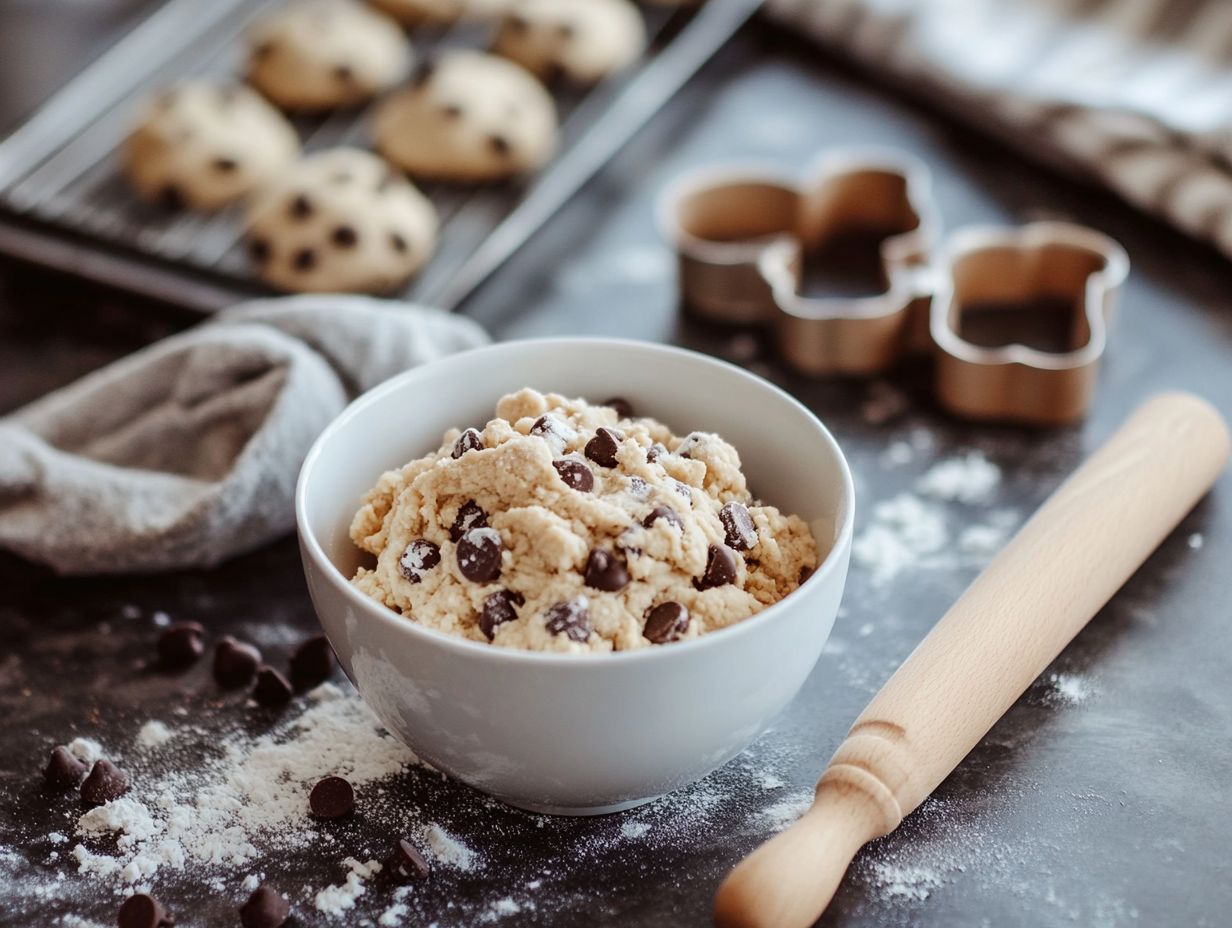
Chilling your cookie dough before baking significantly enhances the flavor and texture of your gluten-free cookies, allowing all the ingredients to meld together for a richer taste.
The chilling process involves refrigerating the dough for at least 30 minutes, which not only improves the overall structure but also reduces spread during baking. This step is especially important for gluten-free recipes, as achieving the right consistency can be quite a challenge without gluten.
By refrigerating the dough, you allow the moisture to fully hydrate the flour, resulting in a chewier texture that s hard to resist.
Chill the dough for optimal results! Doing this for up to 24 hours intensifies the flavors beautifully. When you’re planning ahead, storing your cookie dough in an airtight container makes it simple to whip up delicious cookies whenever the craving strikes.
3. Don’t Overmix
Avoiding the temptation to overmix your gluten-free cookie dough is essential for achieving that perfect texture. Overmixing can transform your cookies from chewy delights into tough disappointments.
When you mix gluten-free flours too much, the delicate structure formed by the ingredients can suffer. This leads to cookies that fall short of the softness and tenderness you expect. Crafting gluten-free cookies is a unique process that differs from traditional baking. It requires your careful attention to mixing techniques to ensure the right moisture balance is maintained.
To mix the dough effectively without compromising its texture, begin by thoroughly combining the dry ingredients before incorporating the wet components. Mixing just until everything is integrated allows the fats to blend in without introducing any unnecessary toughness. Opt for a gentle folding method or use a spatula instead of a mixer to minimize overmixing, enhancing your overall cookie experience.
4. Experiment with Different Flours
Experimenting with different flours can lead you to exciting and unique flavor profiles in your gluten-free cookies. This allows you to uncover new favorites that go beyond the traditional gluten-free options.
By incorporating a variety of gluten-free alternatives like almond, coconut, or oat flour, you can significantly elevate both the taste and texture of your creations. Each flour brings its own charm almond flour contributes a delightful nutty richness, while coconut flour infuses a subtle sweetness and a satisfying chewiness.
To achieve the best results, it s crucial to mix and match these flours, often leading to delightful surprises in flavor and mouthfeel. Start with small batches to fine-tune your ratios, keeping in mind that some flours absorb more moisture than others, so adjust accordingly.
With a spirit of adventure, your journey through gluten-free baking can be not only enjoyable but also incredibly rewarding.
Frequently Asked Questions
To make Gluten-Free Chocolate Chip Cookies, you will need high-quality gluten-free flour, such as those from King Arthur Flour or Bob’s Red Mill, baking powder, sugar, butter, eggs, vanilla extract, and any additional mix-ins or flavorings of your choice.
No, regular flour contains gluten, which is not suitable for those with gluten intolerances or celiac disease. It is important to use gluten-free flour specifically when making gluten-free cookies.
When making gluten-free cookies, it is important to read the labels of all your ingredients to ensure they are gluten-free. Look for certification labels on the packaging, such as the “Certified Gluten-Free” label. Following trusted recipes will also help ensure compliance with gluten-free standards.
No, you do not need any special equipment to make gluten-free cookies. A mixing bowl, spoon, measuring cups, and baking sheet are all you need to get started.
To prevent your cookies from crumbling, make sure to use a gluten-free flour blend that contains xanthan gum. This ingredient helps to bind the ingredients together and prevent them from falling apart.
Yes, you can freeze gluten-free cookie dough for up to 3 months. To do so, roll the dough into balls and place them on a baking sheet lined with parchment paper. Freeze the dough balls for a few hours, then transfer them to a freezer-safe bag or container. When ready to bake, simply place the frozen dough balls on a baking sheet and add a few extra minutes to the baking time.
Now that you have these tips and insights for making gluten-free cookies, it’s time to get baking! Experiment, have fun, and share your experiences with others.

